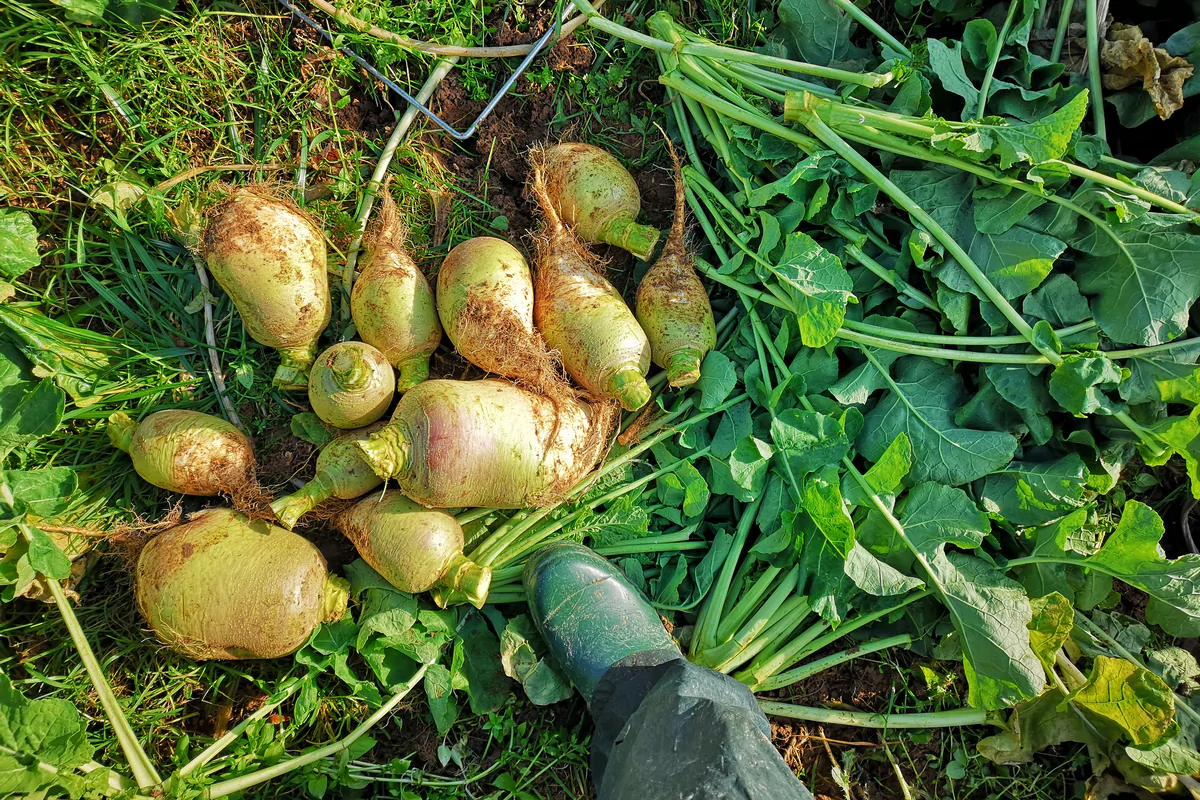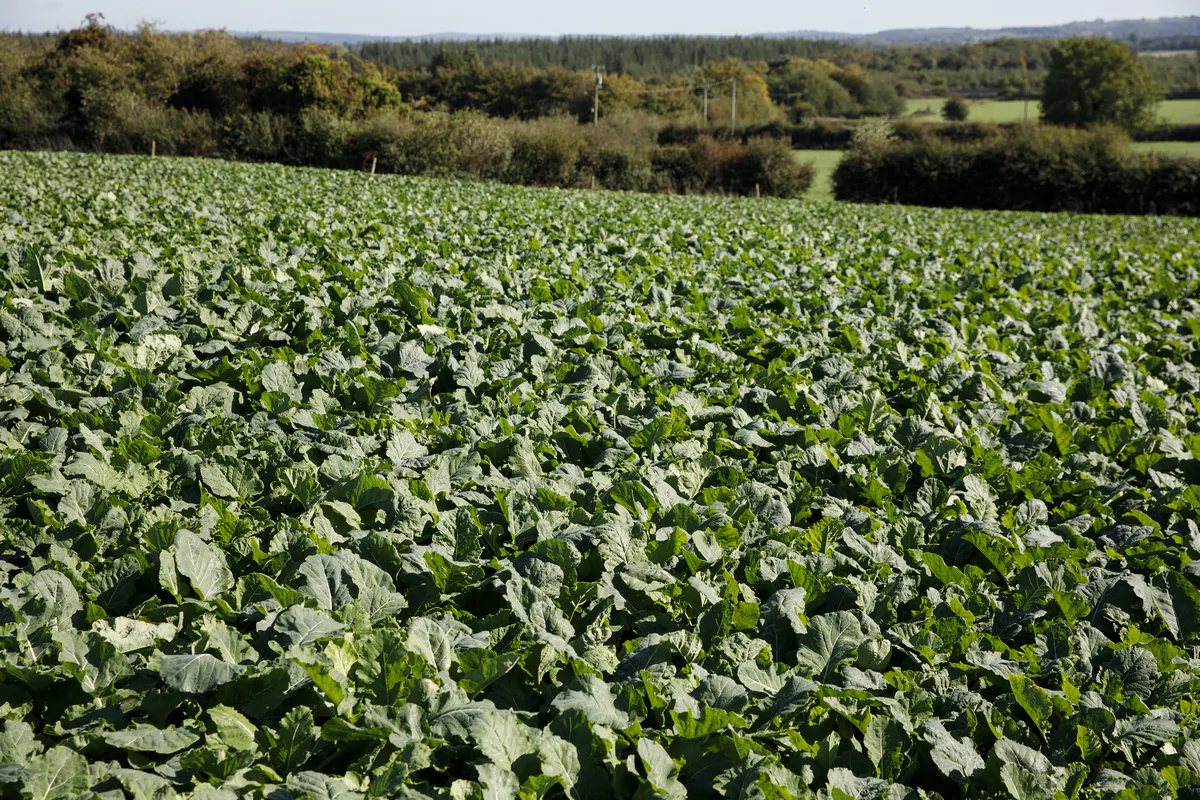Brassicas provide a flexible, cost-effective, nutritious option for outwintering cattle and sheep, reducing the need for winter housing and bought-in feed. But good management is essential. We answer some common questions about brassica management and hear from two farmers using them successfully.
Can brassicas help growth rates and stock performance?
Brassicas are an ideal crop to use for outwintering cattle and sheep as they are high in protein and energy, supporting performance without the need for bought-in concentrates.
Chris Ruffley, Assistant Farm Manager at Harper Adams University, uses Maris Kestrel kale for outwintering all his in-calf dairy heifers. “Since starting outwintering on Maris Kestrel kale we haven’t looked back. The animals do better outside in terms of growth rate and health. We’ve achieved growth rates of 1.29 kg/day.”
In South Lanarkshire, Andrew Baillie outwinters his suckler cows on Maris Kestrel kale and Triumph swedes, as well as finishing his pedigree rams for sale on stubble turnips.
“Many buyers comment on how active and fertile the forage-finished rams are when sold. Rams leaving my farm for another grass or forage-based system don’t suffer the same checks and drop-off in performance they would if accustomed to a concentrate-based diet. So, as well as saving money on concentrate, we are also producing a better product. It’s a win-win situation.”
How cost-effective are brassicas for outwintering?
Outwintering cattle and sheep on brassicas can reduce both housing and associated labour costs over winter, as well as feed costs by minimising the need for bought-in concentrates.
“We started using a range of alternative forage crops about eight years ago and they have helped us reduce winter feed costs dramatically,” explains Andrew. “It used to cost us 98p a day to feed cows over the winter period but now it’s down to 22p. Our concentrate feed use for all our ewes has also dropped from 22-23 tonnes a year, to just five tonnes.”
How do I measure a brassica crop?
Careful assessment of dry matter yield is important to optimise productivity and plan feed requirements accurately. When your brassica crop reaches maturity in mid-September, it's the ideal time to measure.
- Place a 1 m square frame around the brassica crop.
- Use shears to cut the plants (approximately 10 cm from the ground)
- Place in a bag
- Weigh the bag and record the weight per m²
- To calculate DM yield per hectare, multiply the fresh weight per m² by 10,000. Then multiply by the expected crop dry matter percentage. For example: Kale from 1 m² = 5 kg fresh weight x 10,000 = 50,000 kg freshweight/ha. Average kale dry matter = 16% (50,000 x 0.16 = 8,000 kg (8 t DM/ha).
Expected dry matter percentage by crop
| Crop | Dry matter yield (kg/ha) | Dry matter (%) |
| Swedes (e.g. Triumph) | 9-14,000 | 10-12% |
| Kale (e.g. Maris Kestrel) | 11-12,000 | 12-15% |
| Turnip (e.g. Appin, Vollenda) | 6,500 | 9-12% |
| Hybrid Brassica (e.g. Swift, Redstart) | 7-10,000 | 12-14% |
How much of the diet should be grazed brassicas?
Brassicas should not make up more than 70% of the dry matter intake, and only 30% in lactating cows. Therefore, it is important to provide an additional source of fibre when outwintering cattle or sheep. This could be hay, straw, or silage.
“For supplementary fibre, we feed haylage alongside the kale, as we’ve found this is the most cost-effective option,” explains Chris.
How do I calculate the amount of brassica to allocate each day?
Understanding a crop’s dry matter percentage helps determine crop allocation and how much the fence is moved each day when strip grazing. Through careful planning and accurate allocations, strip grazing can help to achieve 85-90% crop utilisation. As a rule of thumb, animals out-wintering need a daily dry matter intake equivalent to at least 2.5% of their bodyweight. This is higher for youngstock and their requirements increase as they gain weight over the grazing period.
How to calculate crop allocation
Based on a 270 kg weanling requiring 8 kg DM/day
| Requirement | |
| 1. Estimated livestock total intake | 8 kg DM/day |
| 2. Percentage of grazed brassicas | 70% |
| 3. Brassica daily requirements (1. x 2.) | 5.6 kg DM |
| 4. Number of livestock | 25 |
| 5. Daily requirements from brassicas (3. x 4.) | 140 kg DM |
| 6. Estimated crop DM yield/m2* | 0.56 kg DM/m2 |
| 7. Total daily grazing area required (5. ÷ 6.) | 250 m2 of brassica |
| 8. Length of feed fence | 125 m |
| 9. Fence to be moved (7. ÷ 8.) | 2 m/day |
| *Based on crop yields of 8 t DM/ha (0.8 kg/m2) x 70% utilisation | |
Do I need to supplement minerals when grazing brassicas?
Livestock grazing brassicas over winter need to receive supplementary minerals, particularly copper, selenium and iodine. These are given most effectively as bolus but can be provided as licks or bags on bales.
“One of the most critical things when grazing brassicas is to avoid any mineral deficiencies, particularly iodine,” advises Chris. “We give a mineral bolus as this is the only health-related issue we find needs addressing. Overall, their health is much better when out-wintering on kale.”
How to introduce livestock to brassica crops?
Introduce brassicas to animals gradually. Provide a run-back of grass and introduce stock gradually to help acclimatise the rumen, advises Germinal forage expert William Fleming.
“Don’t put them onto the crop hungry. Allow them to be relatively full and run them back and forward between grass and the brassica initially so they don’t gorge themselves. You should build up to unrestricted access over seven to 10 days.”
If practical, use two electric fences so if the stock break through the first wire they cannot break onto the full crop and gorge themselves.
If grazing is wet, should I move livestock to run-off areas at night?
Moving stock is more likely to increase the risk of poaching by concentrating the footfall on a narrow area. If animals are well fed, they should be content to stand and lie on drier, just grazed areas. And if there is more hay or straw than they need, they may lay on it.
Expert advice for outwintering cattle and sheep
To learn more, you can view our brassica management guide here or contact our forage experts below to discuss outwintering options.
William Fleming, Area Sales Manager, Scotland and Northeast England
T: 07971 640428
E: william.fleming@germinal.com
Paul Morgan, Area Sales Manager, Southwest
T: 07713 878069
Harley Brown-Keech, Area Sales Manager
T: 07880 469645


